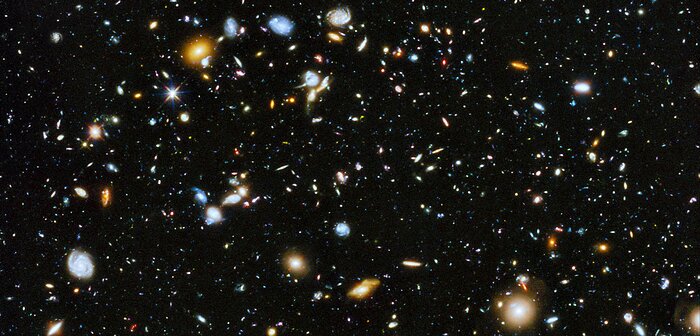¡Lo sentimos! Esta página aún no está disponible en su idioma preferido, por lo que estamos mostrando la versión original.
An excerpt of the Hubble Deep Field
The Universe is crammed with galaxies, as illustrated by the Hubble Ultra-Deep Field (pictured), but if it’s brighter than expected, then there could be even more galactic structures than previously thought.
Créditos:NASA, ESA, H. Teplitz and M. Rafelski (IPAC/Caltech), A. Koekemoer (STScI), R. Windhorst (Arizona State University), and Z. Levay (STScI)
About the Image
| Id: | STScI-gallery-1427a-2000x960 |
| Tipo: | Simulation |
| Release date: | 23 de Marzo de 2021 a las 23:49 |
| Size: | 2000 x 960 px |
Sobre el Objeto
| Constellation: | Fornax |
| Categoría: | Galaxies |
Fondos de Pantalla
Coordenadas
| Posición (AR): | 3 32 37.18 |
| Posición (Dec): | -27° 46' 45.71" |
| Campo visual: | 2.30 x 1.11 arcminutes |
| Orientación: | North is 52.0° left of vertical |
Colores y Filtros
| Banda | Longitud de Onda | Telescopio |
|---|---|---|
| Ultraviolet UV | 275 nm | Hubble Space Telescope WFC3 |
| Optical V | 606 nm | Hubble Space Telescope ACS |
| Optical B | 435 nm | Hubble Space Telescope ACS |
| Optical U | 336 nm | Hubble Space Telescope WFC3 |
| Ultraviolet UV | 225 nm | Hubble Space Telescope WFC3 |
| Optical Long Pass | 150 nm | Hubble Space Telescope ACS |
| Optical I | 775 nm | Hubble Space Telescope ACS |
| Infrared Y | 1.05 μm | Hubble Space Telescope WFC3 |
| Optical Long Pass | 850 nm | Hubble Space Telescope ACS |
| Optical I | 814 nm | Hubble Space Telescope ACS |
| Infrared H | 1.6 μm | Hubble Space Telescope WFC3 |
| Infrared J | 1.25 μm | Hubble Space Telescope WFC3 |
| Infrared J/H | 1.4 μm | Hubble Space Telescope WFC3 |

